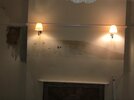- Joined
- 10 Dec 2022
- Messages
- 11
- Reaction score
- 0
- Country

Hi All!
We have recently purchased a 1930s built house that was lying unoccupied for over a year. Ever since the purchase we have been discovering one problem after another. There is damp everywhere, wetness and clay heaving in the crawl space, roofing needs rebuilt, etc. We spent all our money on the purchase and now have no additional budget to spare for the multitude of repair work needed. We are relying solely on our own manpower, DIY expertise and the guidance from you all.
Coming to you all today for a chimney related concern. There are 2 chimneys on the roof and 1 of them has been closed. However, there’s condensation happening in that closed chimney. In fact, the room right below this chimney has a major damp issue. Damp spot starts from near the top and spreads in L shape to the bottom and to the right of the wall.
We have been told installing airbricks in the chimney should help. Reaching out to get some guidance. Given the chimney is closed we are not sure what’s the source of condensation - as in from where is this hot / cold air coming in. Also, will air bricks solve the concern?
Thank you all very much in advance for all the guidance and help here.
We have recently purchased a 1930s built house that was lying unoccupied for over a year. Ever since the purchase we have been discovering one problem after another. There is damp everywhere, wetness and clay heaving in the crawl space, roofing needs rebuilt, etc. We spent all our money on the purchase and now have no additional budget to spare for the multitude of repair work needed. We are relying solely on our own manpower, DIY expertise and the guidance from you all.
Coming to you all today for a chimney related concern. There are 2 chimneys on the roof and 1 of them has been closed. However, there’s condensation happening in that closed chimney. In fact, the room right below this chimney has a major damp issue. Damp spot starts from near the top and spreads in L shape to the bottom and to the right of the wall.
We have been told installing airbricks in the chimney should help. Reaching out to get some guidance. Given the chimney is closed we are not sure what’s the source of condensation - as in from where is this hot / cold air coming in. Also, will air bricks solve the concern?
Thank you all very much in advance for all the guidance and help here.

